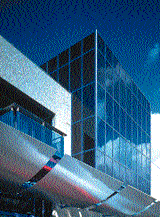
 |
Built environment. Embedded generation |

In Europe, almost 52% of the energy supplied by the utilities is consumed within the build environment. This implies that strategies for sustainability and energy conservation would be worth the while if it is focused and applied in this area.
The concept of Embedded Generation in the transmission of renewable energy leads to the idea of exploiting all possible renewable resources at a particular site ie. the build environment, in an attempt to meet the demand load. They consists of two generating components, Active and Passive renewables.
Active renewables involves the direct conversion of renewable energy to electricity or heat ie. wind turbines, photovoltaics, hydroelectric, geothermal, etc.
Passive systems on the other hand is the second-hand energy, obtained from waste heat off of PV cells, daylighting or generally, energy obtained through any indirect means.
Some of the advantages of Embedded Generation include:
Transmission of electricity over distances can incur transmission losses in the range of 5-7%. This figure includes losses from the transmission lines as well as substations and the associated electrical components. This is seen as a savings when the distance of transmission is reduced in embedded generation
When the transmission distances is reduced, the construction cost of Substation, Transmission Towers and Right of Way would also be reduced or eliminated all together. Especially in city centers where transmission is achieved through underground cables, there could be substantial savings involved as the cost of these cables can be 10 -20 times that of overhead lines.
The environmental benefits associated with embedded generation is related to the reduced construction in long distance transmission (substation buildings and transmission towers) as they involve the clearing of land and trees.
Also a benefit of embedded generation is the Corona Effect which is associated with overhead transmission lines. This involves noise disturbance and transmission interference to the surrounding population.
The national electricity grid is saturated with supplies from existing power generators and by adding in extra amounts of electricity from renewable sources, this would only be wasted in the form of heat. It would be better if this generated electricity is used to satisfy a demand load as in an embedded generation scheme and the total energy consumption is reduced at the point of demand.
The issue of stability and reliability of supply from the power electronics point of view can be improved in an embedded generation scheme as opposed to the supply of electricity over long distance. This is attained through shorter response time and better controls over the embedded systems.
The ability to design the supply to match the demand as in an embedded generation scheme, again, would reduce unnecessary wastage as the demand profile is better defined for a smaller load than it is for supplying a whole region or country via the grid.
Embedded generation offers an excellent option for the transmission of energy at the local level and coupled with the growing interest/research in renewable energy within the build environment, it would make a good combination in the way energy is generated and transmitted in the future.
